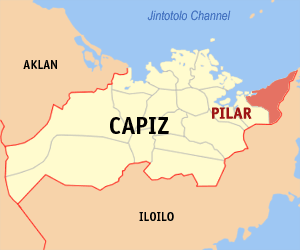
Pilar, Capiz
Encyclopedia

Philippines
The Philippines , officially known as the Republic of the Philippines , is a country in Southeast Asia in the western Pacific Ocean. To its north across the Luzon Strait lies Taiwan. West across the South China Sea sits Vietnam...
. According to the 2000 census, it has a population of 38,903 people in 7,747 households.
History & Culture
The coastal town sprang out from an AustronesianAustronesian people
The Austronesian-speaking peoples are various populations in Oceania and Southeast Asia that speak languages of the Austronesian family. They include Taiwanese aborigines; the majority ethnic groups of East Timor, Indonesia, Malaysia, the Philippines, Brunei, Madagascar, Micronesia, and Polynesia,...
settlement in the early 16th century when indio natives managed to escape colonial tyranny from the Spaniards. The settlement was then known as Sibala, named after the river that ran through the coastal village. In 1570, however, the settlement was seized by Spanish colonial officials and the guardia civil took full control of the village. It later flourished into a bigger and prosperous town and was renamed after its designated patron saint La Nuestra Señora del Pilar ( Our Lady of the Pillar). Several friars and missionaries were assigned to preach in the town since then until it later received its permanent parish priest.
There had been a famous resistance called the Battle of Balisong during the Philippine Revolution in the 19th century as an attempt to overthrow Spanish officials in the municipality led by local revolutionaries Juan Arce and Dalmacio Patricio.
Today, an iconic 12-foot landmark of the Virgin Mary is visible at a mountaintop in Brgy. Dulangan, built by an affluent Chinese-Filipino merchant in honor of the town's patron saint, which is also said to have conducted miraculous powers to its devotees several times.
The town celebrates its annual feast along with the coming of the sacred Santisima Trinidad (The Holy Trinity), an early 18th century wooden figurine from Mexico found by local fishermen in the shores of the town during the British invasion of the Philippines in 1762. The figurine was said to be brought over to the Pacific by a Galleon trading ship from the port of Acapulco
Acapulco
Acapulco is a city, municipality and major sea port in the state of Guerrero on the Pacific coast of Mexico, southwest from Mexico City. Acapulco is located on a deep, semi-circular bay and has been a port since the early colonial period of Mexico’s history...
, Mexico
Mexico
The United Mexican States , commonly known as Mexico , is a federal constitutional republic in North America. It is bordered on the north by the United States; on the south and west by the Pacific Ocean; on the southeast by Guatemala, Belize, and the Caribbean Sea; and on the east by the Gulf of...
which was destroyed by British warships during its route in Luzon and was washed off to the coast of Pilar. It is now still visible at the altar of the town's church, the Parish of the Most Holy Trinity.
The town is also known for its rich local heritage in mythology and folklore of legends and supernaturalism. The Legend of the Golden Shiptells the myth of a beautiful fairy that dwells in the caves of the town's mountainous forests and seduces young men every full moon wherein an illusionary lake appears inside the cave of Balisong and the mistress disappears with her victims in a golden ship along with the fading of the lake at sunrise.
In 1949, the sitios and barrios of Aranguel, Culilang, Pandan, Pinamihagan, Cadoulan, Quiajo, Sangcal, Pondol, Marita, Madulano, Jabuyana, Bo-ac, Cabugcabug, Goce Badiangon, Bayuyan, Agbobolo, Cubay, Ibaca, and the sitio of Lotudlotud which was converted into a barrio of Elizalde was separated from this town and formed into the separate town of President Roxas
President Roxas, Capiz
President Roxas is a 4th class municipality in the province of Capiz, Philippines. According to the 2000 census, it has a population of 27,531 people in 5,119 households....
by virtue of Republic Act No. 374.
People & Economy
Pilar is politically classified as a 4th class economy. Development in basic infrastructure has been stagnant during the last decades. Annual income is low and poverty rates are said to be high, although the town has also seen greater years. The rural municipality is said to be rich in natural resources such as aquatic and mineral wealth. It used to be a very strong seafood producer in the province and once even possessed its own sugar and mining industry.Major agricultural products of the town include fish, prawn, crab, rice, sugar, cattle and poultry. The town also has its own Baptist Church and Iglesia ni Kristo Parish as well as its own rural bank along the town market. Dulangan and Casanayan serve as satellite villages of the town.
Most of the town's population are made up by Austronesian descendants, followed by Aeta
Aeta
The Aeta , Agta or Ayta are an indigenous people who live in scattered, isolated mountainous parts of Luzon, Philippines. They are considered to be Negritos, who are dark to very dark brown-skinned and tend to have features such as a small stature, small frame, curly to kinky afro-like textured...
s and a few of Chinese
Chinese Filipino
A Chinese Filipino derived from two words: "Tsino" and "Pinoy" ) is a Philippine national of Chinese ethnicity but born/raised in the Philippines....
and Spanish ancestry.
Geography
Pilar is politically subdivided into 24 barangayBarangay
A barangay is the smallest administrative division in the Philippines and is the native Filipino term for a village, district or ward...
s.
|
|

